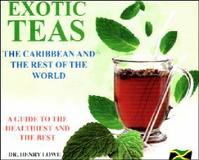Mel Cooke, Gleaner Writer
Title: Exotic Teas: A Guide to the Healthiest and the Best
Author: Dr Henry Lowe
CONFESSION. I have never been much of a tea drinker. I can probably count the number of times I have indulged in a hot cuppa over the past decade in just over a double handful.
But after reading Dr Henry Lowes Exotic Teas, The Caribbean and the Rest of the World, I am much more prone to firing up a burner and brewing some of the hot stuff. It does not hurt that the handily sized, all glossy, all-colour, picture-filled book is subtitled A Guide to the Healthiest and the Best.
The attractive, highly informative, reader-friendly book is sure to be an eye-opener to even those who sip their tea regularly; after all, chances are, they have inherited a habit that they have heard and believe instinctively is good for them. Sounds like Christianity, come to think of it, but Exotic Teas does not pretend to be the Bible and there are no parables to figure out.
Therapeutic Values
Exotic Teas is divided into two sections, the first dealing with a History and Overview of Teas and the second bringing it home to the Caribbean with A Compilation of Seventy-Three Traditional Teas and their Documented Scientific Thera-peutic Values.
Section One makes the distinction among the main types of oriental tea, namely green, black, oolong and herbal tea. I am willing to bet a couple leaves that most tea drinkers have a preference (personally I had never even heard of oolong tea before) based on appearance and taste, but have absolutely no idea what makes them different. Actually, there is not much as it relates to the plant origins, as they all come from the tea plant, Camellia Sinensis.
The differentiation lies in the preparation. Green tea is dried quickly with hot air and without major crushing after being picked and is high in nutrients and mine-rals, while black tea goes through the longer process of full fermentation prior to drying, in which the leaf colour darkens to give it its black colour. Oolong tea is a semi-fermented tea that is made from large, mature leaves after being picked, the leaves are wit-hered to remove moisture and are left to dry in the shade before the semi-fermentation process begins. White tea, fermented only in China, is the same as green tea, only that the buds of the tea plant are used to make it.
The herbal teas, now, are totally different, in that they do not contain any leaves from the Camellia Sinensis Plant, but are made from the flowers, berries, peels, seeds, leaves and roots of many different plants.
Lowe also tells us what the diffe-rent tea varieties are good for, so the indulgers can do more than nod sagely as they drink and burp the gas it displaces with satisfaction. Green tea contains Vitamin C, which helps strengthen our immune system and promotes good health, as well as fluorine which strengthens bones and protects the teeth.
cholesterol level
Black tea has a high concentration of flavonoids, which reduce blockage of the arteries and act as an antioxidant. Oolong is effective against indigestion and helps lower cholesterol level in the body. No healthy properties are listed for white tea, while the herbal teas get a whole section for themselves. And they deserve it.
Lowe expands on the health enhancement properties of each type of tea and those who arent yet familiar with oolong should be interested to know that it is effective in delaying the appearance of signs of ageing, such as dark spots and wrinkles. Why do cosmetic surgery when you can sip? It certainly costs less and your face will actually move naturally.
And Lowe does point out that in terms of health both green and black teas have yielded quite similar results.
The herbal teas, now, are a different matter. Lowe writes that although modern medicine does not readily accept the fact that herbs, and by extension herbal teas, have healing properties, approximately 70 per cent of pharmaceutical drugs manufactured today are derived from natural sources substances such as plants. Moreover, many common or so-called everyday drugs are derived from ancient herbal remedies which were used to cure the same ailments that afflicted mankind then as they are being used to cure today.
stress reducer
Lowe lists 12 general benefits of herbal teas, among them as an anti-depressant, stress reducer and natural energy enhancers. Then, from ackee (Blighia Sapdia), good for colds, flu, mucous congestion and (with lemon or lime juice added) asthma through to wild tobacco (Pluchea Odorata), used for the onset of asthma attacks, as well as coughs, colds and flu, he addresses the over 70 herbal teas. Chigger nut, donkey weed, hog plum and jack-in-the-bush are among those in between. And those are only some of the many herbal teas.
And yes ganja (Cannabis Sativa) does make the list as useful for he treatment of the symptoms of asthma, headaches, vision improvement, fevers and cold. The tea has also been used to treat scalp problems, such as dandruff and to stimulate hair growth.
He does have a list of cautions, though, including be aware of the toxicity of certain herbs.
There is a picture of each plant.
So from advice on brewing herbal teas and maintaining a herb garden through to how the oriental teas we commonly used are grown, harvested, processed and stored, Lowe makes brewing of a cuppa a wonderful, healthy proposition.
Oh. Those who take their tea of a variety black will be happy to know that without a sweetener it contains a mere four calories. That increases to up to 40 when the sweet stuff is added.

